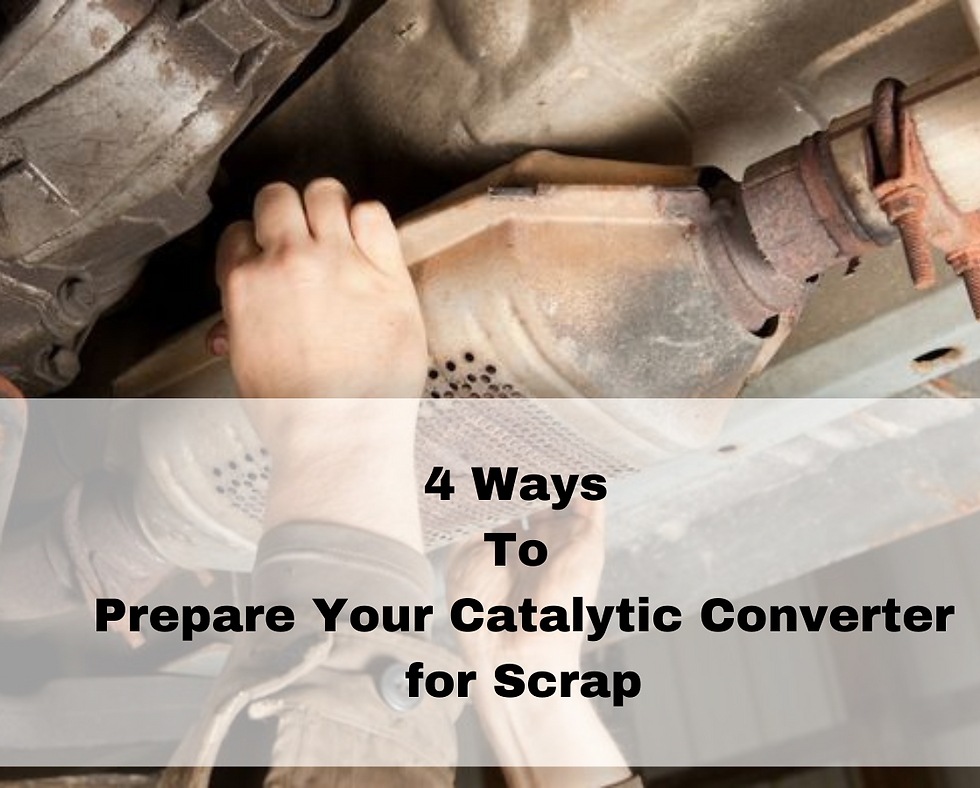4 Ways to Prepare Your Catalytic Converter for Scrap
- belanger converter
- Jul 26, 2022
- 4 min read

There are four main ways to prepare catalytic converters for recycling. The advice that follows focuses on automotive parts but also applies to other equipment that uses an internal combustion engine or a diesel engine, such as forklifts and ships. Electrical generators and wood stoves sometimes have catalytic converters. Regardless of the application, all of these pollution control devices use valuable platinum group metals (PGMs) to clean the engine’s emissions. Old catalytic converters have a wide range of values on the scrap market so the first thing you need to do is to evaluate your inventory.
1 - Find Out What You’ve Got
Know what you have. You can find the model number on the steel case of each converter. The design may also tell you if this is an aftermarket converter or original equipment. The aftermarket parts normally have an arrow on the case indicating which way the exhaust flows. These parts tend to have less of the valuable PGMs. Whether the converter is original or not, you also want to record the make, model, and year of the vehicle it came from.
2 - Take Care When Removing the Converter
Cut the catalytic converter away with a reciprocating saw. Cut as close as possible to the converter’s steel shell. Do not open the converter and remove the honeycomb. Recyclers need to have a model number associated with each honeycomb, as this is the only way to be sure of what they have. The converter cores tend to look similar even if their values are substantially different. Furthermore, the converter shell protects that valuable core from damage. Damaged honeycombs and missing information translate to lower purchase prices.
And, if you have a lot of old catalytic converters, you might need some help keeping records of what you have and the current market value. Belanger’s Group Catalyst app can help. Recycling firms can also remove the honeycomb for you.
3 - Find a Contractor to Recycle Your Converters
You can do this yourself but probably should not. Decanning can be hazardous, because of the materials you have to handle. Setting up a proper system for removing those valuable honeycomb cores and handling them can be expensive. You also separate the core from the casing that identifies what model of converter it came from, which is not a good idea. Unless you have pallets full of old catalytic converters, you’ll have trouble earning a profit. You also need to melt the honeycombs and do a bit more processing to get the PGMs inside. Better to find a recycling firm that can help.
4 - Hedge the Precious Metal Content
Extracting the PGMs from a catalytic converter is not a DIY project. You’ll need to find a company that can do this work for you. You can sometimes find a vendor who will remove the honeycombs and process them while also hedging the precious metals. This relieves you of the responsibility of selling whatever PGMs the converters yielded. You also gain some protection from changes in precious metal prices. An ounce of platinum might be $1,990 today and $1,890 in three weeks. If you have 10 ounces of platinum tied up in multiple catalytic converters, you lose $1,000 by waiting. Of course, the price could also go up in the future.
Miscellaneous Things to Consider
You might find a catalytic converter on something other than a car or light truck. Some diesel vehicles, generators, kerosene heaters and wood stoves, motorcycles, and ships have catalytic converters. These devices will also contain valuable PGMs. In that case, you still want to collect the same kind of information – what make and model of vehicle or generator was it on? What year was it made? If you plan to recycle in bulk, make arrangements to store those converters securely.
Don’t toss the oxygen sensors either. Not every recycler handles those, but they do have some scrap value. The sensor uses a tiny amount of a platinum group metal, with older and less sensitive designs using a bit more.
If you are reading this article, you probably want to recycle in bulk, either because your repair shop or scrap yard tends to collect these exhaust parts in the course of doing business. Belanger offers a mobile app that can help with keeping all of your records in order, while you also get a fast and accurate price for each part.
Recycle Catalytic Converters with Confidence
Recycling a stockpile of old catalytic converters is an easy way to make some extra money and help the environment. You just have to know what you have, how to remove the catalytic converters without doing damage, and what to do next. If you have dozens of converters to recycle, you’ll want to organize your records and price things as efficiently as possible. Consider downloading our Group Catalyst app can help with that by giving the latest price for each piece based on the model number. Belanger can also recycle your catalytic converters for you.




Comments